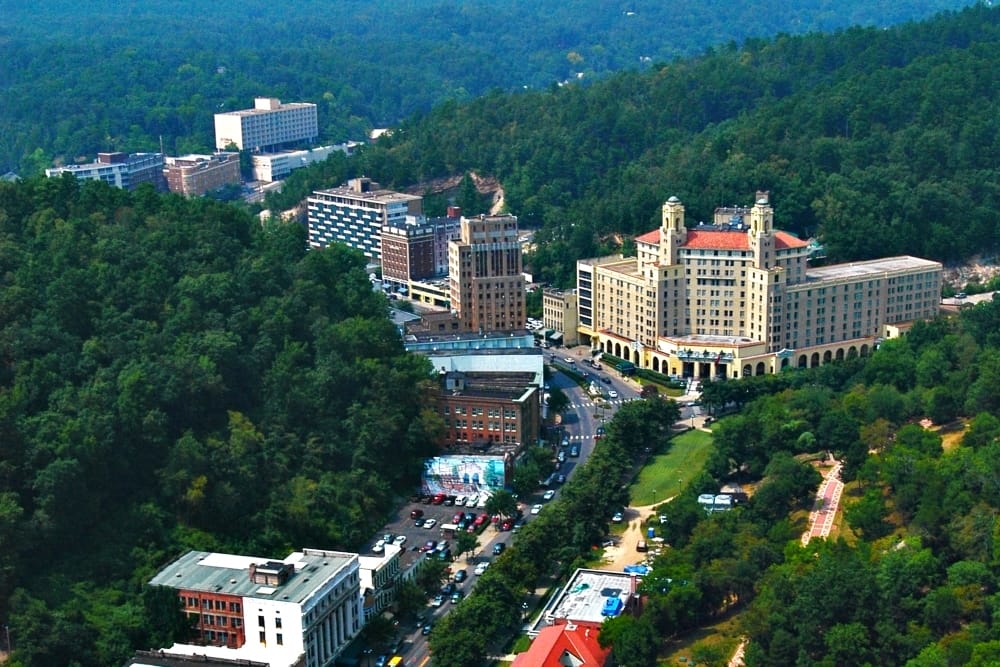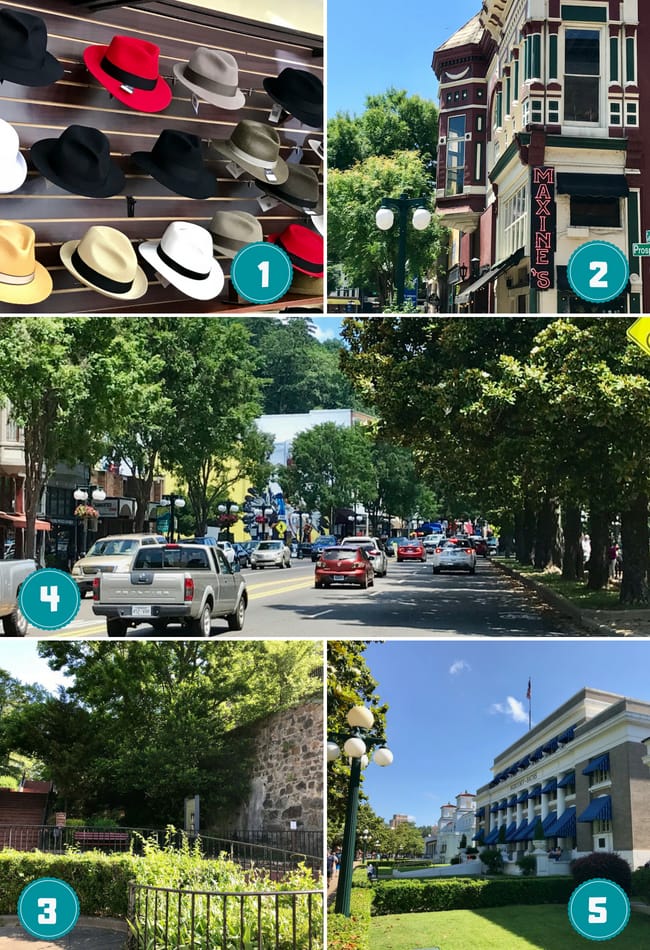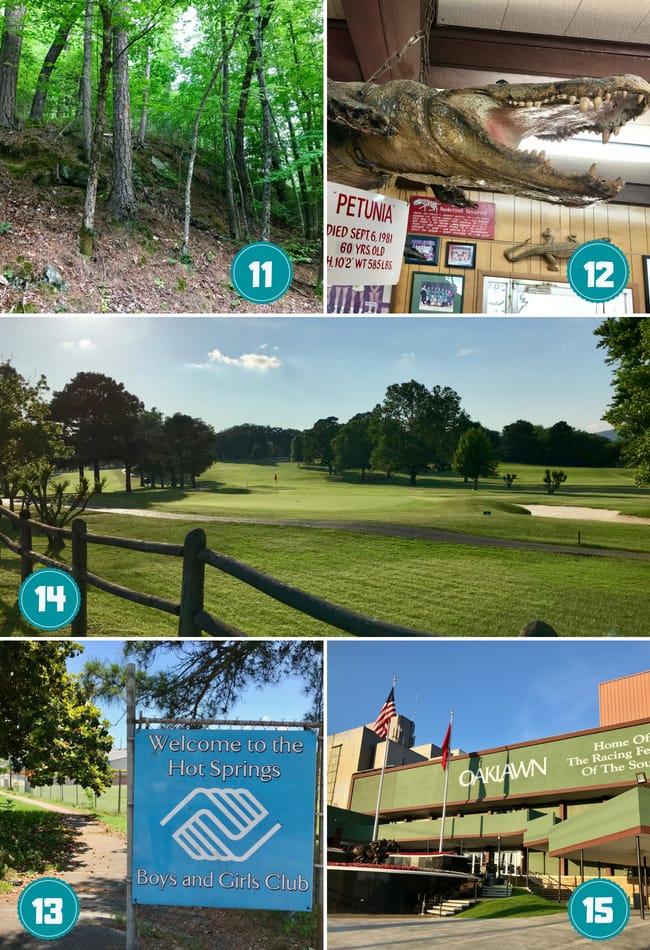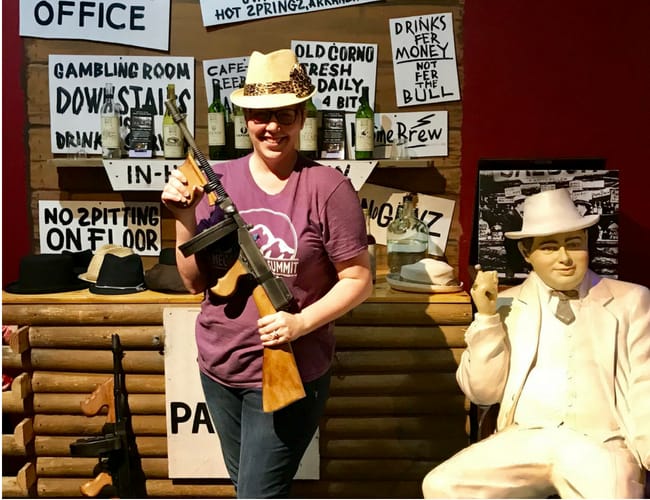

Uh oh...
It appears that you're using a severely outdated version of Safari on Windows. Many features won't work correctly, and functionality can't be guaranteed. Please try viewing this website in Edge, Mozilla, Chrome, or another modern browser. Sorry for any inconvenience this may have caused!
Read More about this safari issue.

Discovered by Hernando de Soto in 1541, Hot Springs is full of history and a whole lot of lore. Many settlers came to the region in pursuit of the healing waters, and once they discovered the beauty of the region, they stayed.
While many famous people came through and stopped in the area, few are more notorious than Al Capone and the other Gangsters of the early 1900s. It seems fitting to find the characters of the Gangster era by going on a scavenger hunt and seeing what we can find. Grab your phone or camera too; you may want to prove you were there. Together, let’s discover the nostalgia and history hidden among the life and ruins of the famed Spa City.
1. A first place to stop is the Gangster Museum of America. Not only will you find the history of this notorious era, but it will also provide the outline of the rest of our journey. It’s been a long time since I left a museum so charged up with fun facts and interesting details. The museum will take you back to the scenery and mindset of the 20s, 30s, and 40s when a normally hidden way of life was shared in public around the roulette table or a slot machine. Seven galleries share the stories of those who made this time in history so intriguing as well as getting you up close and personal with some of the characters who made a sleepy valley town in central Arkansas more than a dot on the map. A tour guide will walk you through each gallery after entering through a bank safe door … after all, that’s where the secrets start.

The rest of the stops listed can be discovered in any order. Where will you head next as you chase the Gangsters?
2. Maxine’s – Named for Madame Maxine Harris Jones, the now-restaurant and live Music Hall, served as a home to the ladies of the night for nearly four decades. The Gangsters (or anyone who could afford it) would call in for some companionship. Because of the underground tunnel system, this could often be done where no one would see them coming or going. These “houses of ill repute” were illegal, but they could pay their monthly fine and stay open. While many would disagree with the business she ran, Maxine was known among the elite of the city and state. She was invited to dinners and walked socially with the politicians and their wives. Her tenacity and ability to chase her goals and fearlessly build a business empire is her true legacy. More than many others, she knew the truth of what happened on The Strip.
3. The Grand Promenade – This luscious and green area was the site of a famous capture and detaining of Lucky Luciano. On April 1, 1936, Luciano was in the Promenade with Hot Springs Chief Detective Herbert Akers and his friend Dutch Majors, when the Hot Springs Police spotted him. Since they had an order from New York State Attorney General, and he was on Federal property, they could take him in. Interestingly enough, he was booked as prisoner number 13 (like Lucky 13) on the Garland County booking sheet that day. Luciano made friends with the Bell Captain at The Arlington Hotel while discussing the plight of his father who was booked one prisoner ahead of Luciano. In an interview, the Bell Captain said of Luciano and the brokers of his time – “they was guys just like you and me, only they didn’t take no crap!”
4. Central Ave was (and still is) the main attraction. One side of the street was considered “Bathhouse Row” and the other “The Strip.” While gambling was illegal in the state of Arkansas, there were ways around nearly everything. Anyone could come here and find anonymity. Often rivalries were put at bay and the mischievous men of the time could enjoy the pleasantries of life out in the open, without fear of being arrested. For more than a century, Hot Springs was just a town with this magnificent water. Many tried to turn the area into more, but local officials kept the city pretty clean until Leo Patrick McLaughlin came along. He worked locally with Judge Verne Ledgerwood begin what grew into a mechanism for revenue through gambling, tourism, and a very “wet” area. Their method was the amusement tax. Bars and slot machines were all taxed monthly, and the owners paid in cash. The cash was then used to pay off the sheriff and police. This new era would continue through the leadership of 5 different Arkansas Governors. Some wonder how this happened. The issues reported were often seen as “local issues,” and a reprimand telegram would be sent to local officials (McLaughlin and Ledgerwood). And, as long as the state kept its recognition and the tourism dollars grew, few complained.
5. Bathhouse Row – Like with many people visiting the area, the healing properties of the waters were much sought after. Over 1 million baths were conducted during the 1930s. The area known as Bathhouse Row completed development of Victorian style houses in 1888. Many of the current structures were built in the early 1920s and survived fires and flooding in the area. The Hale House, the oldest on the block, was originally built in 1892. A thermal cave carved from the mountainside where it sits was used as a “hot room” and is today preserved as a national archaeological site. The Ozark and Quapaw houses, still standing, were originally opened in 1922. Both of these houses catered to a middle economic class with ornate facades and simple but productive interiors. Today, the Ozark Bathhouse is home to a National Park Cultural Center and also houses the artist-in-residence program. The Lamar House hosts the Park’s Resource Management Team and Archives and is a great gift shop where you can taste the water and climb in a bathtub for photos.

6. Hot Spring Spigot – Many doctors during the 1930s would prescribe a week or 2 in Hot Springs as a cure to many ailments. Most didn’t realize that just taking a bath was a big part of what cleaned up the “diseases” they faced. But, maybe there was something to the medicinal properties of the water. Even so, Hot Springs became known as America’s First Resort town and drew a crowd filled by many different social classes. Interestingly, Bonnie and Clyde traveled here to heal Bonnie’s wounds from a car crash. But, in Hot Springs the shame was that you could “hide out” in the open. Often arch enemies would be in town at the same time. Bank robberies were slow during the tourism months because the robbers were all hanging out in Hot Springs!
7. The Arlington Hotel – This hotel is full of so much history, not just from the Gangsters’ period, but with horse jockey and political traffic as well. The current structure opened its doors on January 1, 1925, but the original name dates back to 1875 when the hotel on this site was the largest hotel in the state of Arkansas. And, that hotel originally sat across the street from its present-day location. Even with the baseball teams and the “gamers” in the area, they could still not get more than 400 rooms on their property. So began an interesting turn of events where a boiler room fire burned down the whole building. Interesting because not one person was in the building at the time. Surprising for a famous hotel in a growing tourist area. However, the building across the street where much of the gambling was going on was available for sale. And some might say a certain picture on the day of the fire shows that construction had already begun on the spot to put in a new place for “games of skill.” Al Capone made The Arlington his usual destination, camping out on the 4th floor in suite 443, which still bears his name. While he had a big reputation as a crime boss in Chicago, when Capone and his men were in Hot Springs, they had the reputations of peaceful and enjoyable guys. Even more so, many who interacted with him and his team bragged on how generous they were with their tipping. It was also on the beautiful veranda of The Arlington Hotel where McLaughlin would make a speech promising to make this area prosperous for the city and region. He saw a Central Avenue without enough people and “if they would elect him, he would open this up.” That speech won him the mayoral election and a multi-decade prominence scheming and protecting the “underground” of Hot Springs. Ironically, McLaughlin also practiced law for 45 years in Hot Springs, but some say you can contact the Arkansas Bar Review and he does not show to have been a registered lawyer.
8. The Majestic Hotel – When Al Capone and his boss, Johnny Torrio, first arrived in Hot Springs, they stayed at The Majestic before taking up residence at The Arlington. The beautiful building that set at the Y of Central Avenue as it turned into Park Avenue encompassed “a majestic view” and was one of the most famous hotels in the South. The building was originally constructed in 1882 under the name Avenue Hotel, and the name was changed to Majestic in 1888. The hotel had a streetcar service that would transport guests to and from the bathhouses along Central Ave. Over the years, The Majestic drew in middle and upper-class visitors like the owner of the Anheuser Busch company who’s famed Clydesdale horses were stored in the hotel garage during his wedding. Air conditioning and sliding glass doors were special features that few knew elsewhere. It’s easy to see why the gamblers loved it here. In the mid-80s, as tourism in Hot Springs declined while it was rebuilding after the shutdown of the gambling scene, portions of the hotel were closed, and then it closed altogether in 2006. A fire in 2014 consumed most of the remaining portions of the building. Today, the steps and bricks of the foundation of the building stand as ruins to an abandoned, endangered part of Arkansas architecture.
9. Mountain Valley Spring Water – While they may not love the story, history is history! Al Capone purchased Belvedere Club, an under-performing dairy outside of town. While he wasn’t interested in milk production, he did turn the land into a moonshine distillery. Using science, he was able to produce a clear product. Mountain Valley Spring Water Company has been distributing water from Hot Springs continuously since 1871. They would distribute water for their large dispensers in clear glass bottles with the label impression upside down so that when you flipped it to put it in the dispenser, the label would read right side up. Mr. Capone knew this marketing technique they used so he jumped on board. He would distribute his moonshine in similar clear glass bottles with the Mountain Valley Water logo facing right side up. Hidden under the same logo, he could use the same transportation method to ship his product. You can’t blame a guy for trying because in the 1920s and 30s you could not buy alcohol legally, but if your doctor prescribed it for you, it was alright. Again, it made everyone pay for a doctor’s visit, even if it was just for one of those “basic” ailments.
10. Ohio and Southern Clubs– Owen Madden was “the” guy of the period. He was known as the Peacemaker, and no one came into town without checking in with Owen. He came to the area from New York City where he owned a club in Harlem. His longtime girlfriend Agnes (if you don’t count his longtime simultaneous girlfriend in NY, Mae West) was the Postmaster’s daughter, and together they established an infamous life. The Southern Club, now the Josephine Tussaud Wax Museum, was modeled after his club in NYC. Many consider Madden the architect and “organizer” of the organized crime in the area. His old buddies from the Hell’s Kitchen area in NYC and his warden from Sing Sing came to the area to see him after he was forbidden to return by officials in New York. He was a bad dude and is said to have taken nine bullets at one time. They say if he took his shirt off, “he was all kinds of torn up.” While much that happened is still a mystery, Madden was very generous and remained in Hot Springs until his death. He is buried locally in Greenwood Cemetery. Hot Springs loved Owen Madden.
Today, the Ohio Club is still a sought-after destination. It was opened in 1905 and is known as Arkansas’ oldest bar. Mae West was known to perform here from time to time. The second floor during that time was a speakeasy. The first floor was called the Ohio Cigar Store, and you had to find a secret door that led you upstairs to the gambling spots. They still keep the room upstairs separated for special events.

11. National Park – Another common draw to the area as this was often a place the Gangsters would hide out on manhunts. But, the National Park had been around a long time before that. William Dubar and George Hunter were sent into the area to explore the Ouachita River and stayed for a month at the end of 1804 to study water temperatures and geology. The coveted water led President Andrew Jackson to note the area as Hot Springs Reservation in 1832 for Federal use. This title made it America’s first National Park, preceding Yosemite by 40 years. Through changing times and an expanding area, Hot Springs Reservation became Hot Springs National Park in 1921. They later acquired some of the properties on Bathhouse Row in the mid-1980s and today those structures form the cultural components of the park while still preserving native plant and wildlife species of the area in the surrounding green spaces.
12. Hot Springs Alligator Farm and Petting Zoo – The Hot Springs Alligator Farm was once owned by Jack Bridges, a Central Ave cabdriver who was a favorite of Al Capone. Mr. Bridges claims he once got a $100 tip for “driving Mr. Capone from the Southern Club to The Arlington Hotel, which is across the street.” But, the Alligator Farm was opened in 1902 by HL Campbell who thought the region needed a tourist attraction more than just the thermal waters. At one time it had up to 1500 alligators. Today, it includes alligators and other animals in a display and petting zoo. One of the fun features is participating in the daily feedings of the gators. Some might say that would be scarier than meeting Bugsy, Costello, or Capone in a dark alley.
13. Boys and Girls Club of Hot Springs– Owen Madden was the founder of the Boys and Girls Club of Hot Springs, and for a long time, it remained the largest one in the state of Arkansas. This BGC closed in February 2018, but the location is still home to the Champion Christian College Sport Complex, and Community Center and the ball fields on the property hold significant moments in Hot Springs Baseball history. Madden was a generous man, and this was one of the many ways he invested deeply into this community.
14. Hot Springs Country Club– Just like today, many business deals went down on the golf course. Owen Madden was well-known for spending time at HSCC, as well as Al Capone and Johnny Torrios’ tribe. Interesting fact – Capone would play with up to 40 men at any one time, but as a caddie from the time reported, there would always be one guy carrying an empty bag loaded with a Tommy gun, also known as the “Golf Bag Hunt.”
15. Oaklawn Park – Let’s not forget today’s site of games of chance which had its place in the 1920s and 30s rebellion among the Gangsters. The quintessential scenes took place here. Oaklawn is a horse racing park that originally opened in 1904 with a storied past and rough early years. Gambling was obviously controversial, but a tie-breaking vote in 1929 among the House of Representatives reopened the festivities and saw high activity during the 1930s by increasing payouts to become competitive with horse parks across the nation. Zachary Taylor Davis was the original architect of the park, and he also designed Comiskey Park for the Chicago White Sox and Weeghman Park which later became Wrigley Field. At its opening, Oaklawn featured one of the first glass-enclosed, cooled and heated grandstands, an attractive quality for all the northerners finding “refuge” in the Spa City.
As mentioned above, this era for Gamblers, Gangsters, and “ill repute” went on for nearly four decades. With the local officials involved in the “cover-up” and benefiting from the sources of tourism, this resort town grew and grew. It wasn’t until 1967 when Governor Winthrop Rockefeller raised $1 Million and was elected that his conservative promise to clean up “the largest illegal gambling operation in the US” was put in place. However, Glen Davis, who was hired to clean up the regime, seems to have been the only one to pay jail time over the whole thing after he refused to release the name of one of his informants. After clearing up the circumstances, Davis was released and returned to Little Rock only to see that the law enforcement that helped him were part of the scheme and it was all reestablished. So, Davis returned to Hot Springs and removed the slot machines and gaming equipment himself. This time, he saw the machines destroyed with his own eyes. “Very seldom does a person have a chance to do something that changes history.”
That shift forever changed the nature of Hot Springs. Gambling had been going on in the city for more than a century, and many feared that the town would dry up. But the nostalgia of the hot, thermal waters remained, and the infrastructure of the resort city filled out and continued to grow and thrive.
As for the gambling scene, it was moved to Las Vegas, Nevada where it thrives today. The Vegas Strip was built to clone the life and times of Central Avenue in Hot Springs, Arkansas.
Join the Conversation
Leave a Comment
7 responses to “Chase the Gangsters: Scavenger Hunt Tour of Hot Springs”
 Leave a Reply
Leave a Reply
We do the work.
You check your email.
Sign up for our weekly e-news.
Get stories sent straight to your inbox!












 Leave a Reply
Leave a Reply
[…] Springs is well-known for being a former gangster hot spot, so while I was visiting with Scott, I had to ask the question, “Do you have any good Gangster […]
[…] Chasing the Gangsters in Hot Springs […]
[…] is an American treasure. Since 1875, the hotel has hosted presidents, dignitaries, movie stars, gangsters, sports heroes and scores of others looking to relax and possibly enjoy the spring-fed hot waters […]
[…] the backroads of Arkansas Favorite Museum: Historic Washington Print Museum Favorite City: Hot Springs Favorite Arkansas Getaway Location: Petit Jean State Park Favorite Recording Artist: Johnny Cash […]
[…] Museum | Hot Springs – uncover the storied past of Hot Springs when famous outlaws like Al Capone made Arkansas a second […]
[…] Baseball Trail Arkansas’s National Treasures Mount Holly Cemetery Historic Evergreen Cemetery Chase the Gangsters in Hot Springs Bathhouse Row Monte Ne: Arkansas’s Underwater Resort Marlsgate Plantation The Old Mill Van Buren […]
[…] is an excellent spot for a family outing or visiting other adventure spots in Hot Springs, like the Gangster’s Museum, Historic Hot Springs Baseball Trail, or the Alligator […]